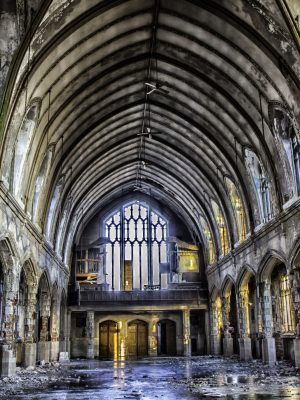The Church’s modern social doctrine was developed in response to the unprecedented cultural, social, economic, and technological changes that occurred in Europe starting in the sixteenth century, but which gained both speed and force with the technological developments of the eighteenth and nineteenth centuries. Before then, mankind’s economic and even social life had rested mainly on a foundation of agriculture. While there had been technological improvements during that time, they were comparatively rare and in general did not unduly disturb the rhythm of economic or social life. Slavery had gradually withered away in response to the subtle effect of Catholic teaching, but again this shift from bondman to free peasant did not fundamentally disturb European life. The Church’s economic ethic found little to criticize in either the feudal system (as that was moderating itself over the course of the Middle Ages) or still less in the urban economies, dominated as they were by those quintessentially Catholic institutions, the craft guilds. The Church did repeatedly clash with the increasingly important banking and commercial sectors over the question of usury, and the fact that the Church continued to uphold the injustice of usury in the face of the nascent capitalist economy shows that the later elaboration of her social doctrine was no novelty but a necessary part of her critique of society.
Pope Pius XI, in his remarkable 1931 encyclical Quadragesimo Anno, summed up the Church’s view on this long-vanished medieval socio-economic order:
“At one period there existed a social order which, though by no means perfect in every respect, corresponded nevertheless in a certain measure to right reason according to the needs and conditions of the times. That this order has long since perished is not due to the fact that it was incapable of development and adaptation to changing needs and circumstances, but rather to the wrong-doing of men. Men were hardened in excessive self-love and refused to extend that order, as was their duty, to the increasing numbers of the people; or else, deceived by the attractions of false liberty and other errors, they grew impatient of every restraint and endeavored to throw off all authority.”
The medieval mind recognized that one of the effects of the fall of our first parents was a tendency toward inordinate attachment to material goods and to money, the universal means by which to obtain such goods. What did the medieval Church do to counteract this sinful tendency of fallen mankind?
“The Church in medieval times did not hesitate to formulate a social moral code. It had specific teachings on the purpose of man’s life and the place of material things in this over-all picture. The doctrine of justice was applied in detail to the market place. While the institution of private property was upheld, the social obligations of ownership were also stressed. The prime importance of the common welfare, as contrasted with individual selfish aims, was insisted upon. . . . In the Christian society of the Middle Ages, the teaching of theologians and the sermons of preachers were more than mere exhortations. They laid down binding rules of conduct, accepted as moral obligations upon the consciences of individual Christians’ (John F. Cronin, Catholic Social Principles (Milwaukee: Bruce, 1950), 11–12).
This article is taken from a chapter in The Prosperity Gospel by Thomas Storck, which is available from TAN Books.








